Sex Tech Hackathon Prototype - Sensploration
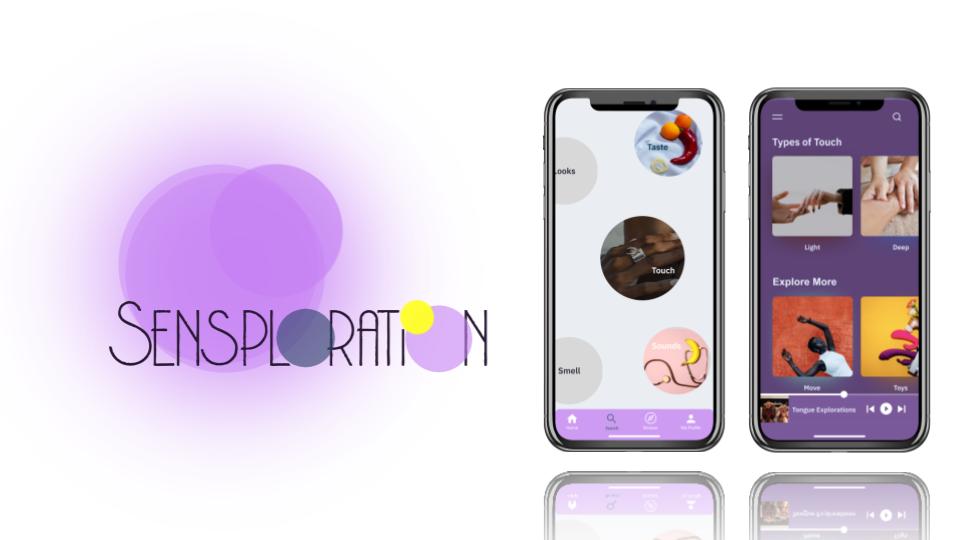
The Hackathon
Within months of organizing the first Sex Tech Hackathon, the co-hosts ran a second one on may May 1–2, 2021 as part of the Rainbows End online festival. I hadn’t heard of any of them — Touchy Feely Tech, Hervisions, Kinky Makers, Creative Code Utrecht. I stumbled upon the event one more morning lying in bed, scrolling through Carolyn Stransky’s tweets.
The hackathon’s consortium of organizers invited “artists, academics, activists, thinkers and tinkerers from all backgrounds and perspectives to take part” and also had numerous talks by makers and people in sex tech. I knew nothing about sex tech, but the idea was enough for me to pay $40 to join (the only hackathon I’ve ever paid for). I almost treated it like a conference.
This year, I teamed up again with my friend Ghonche Tavoosi, podcaster, feminist, activist, product manager and community organizer extraordinare. Last year, we built a working prototype of audio hugs for the LGBTQ community, Pride Polyphony with Emma Lawson. This year, our friend Thomas Liano wanted to address the gap between people wanting to connect to their bodies or find more ways of experiencing pleasure and the availability of inclusive resources to do so.
For the Sex Tech Hackathon, the three themes we could work with were:
- Fair Futures
- Sexual Health = Health
- Dream Devices
It was an open field of possibilites for sex to become more accessible, inclusive, and relevant for people. A note that this hackathon (refreshingly for me) did not have a business component / emphasis.
The Problem
The problem that we wanted to address at the individual level was that many people may not feel entirely connected to their body or the permission to feel bodily pleasure. The messages that we receive from media and our suroundings has, in many ways, limited how we experience our body, and more precisely, how we experience bodily pleasure.
The big picture problem that we wanted to address was the silos within the “experience economy” that has alienated many people and, since 2020 with the pandemic, left people with unsatiated desires. To put it another way, Covid-19 restrictions have shown us the limits of an economic model that focuses on consuming the experiences we are given access to, the ones that are sold to us and that we can afford, instead of focusing on how we experience things.
What people shared with us
To get more insights into this, we did a survey in under 24 hours.
Of our 70+ respondents, 95% said that can experience pleasure through their body. In addition 51% also said that the way they experience it has been shaped by media and education, and 49% felt that these two have limited the way they experience pleasure.
Finally, 69% of people strongly felt that they wanted to try new ways to experience pleasure through their bodies. I have taken strongly to be 9 or 10 out of 10.
Respondents included friends, friends of friends, and strangers online. We asked them to answer anonymously to protect privacy. You can have a look at the spread of data here:
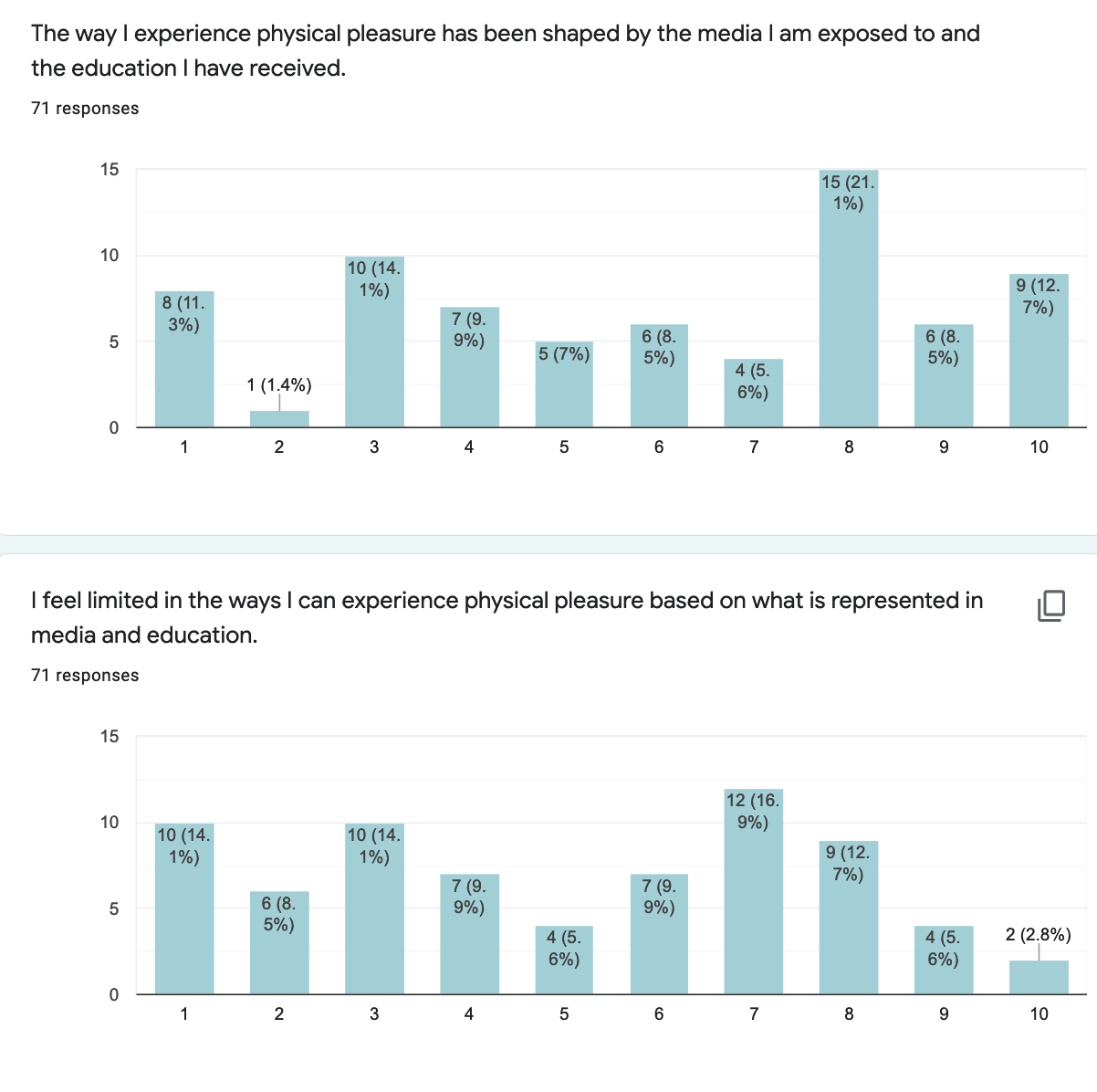
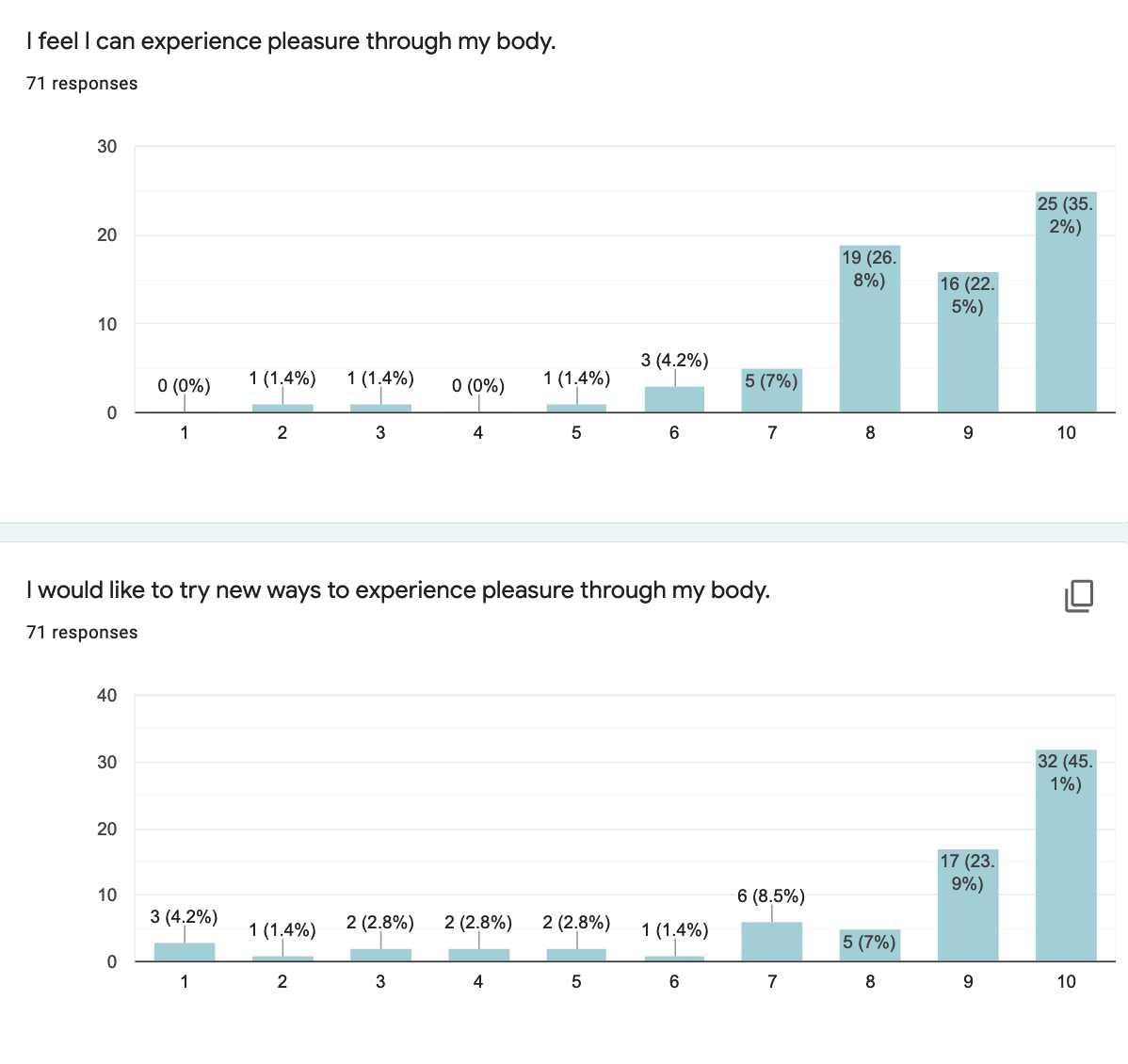
What some survey respondents shared about media and education
“I feel like I have worked on new ways to experience pleasure but I feel like I lack a framework for it and especially to do it with partners.”
“I felt like this was true in the past i.e thinking I was abnormal for not orgasming during penetrative penis in Vagina Sex. However after learning about pleasure on my own terms this has changed my experience drastically.”
“Being queer (and particularly bisexual) isn’t always well represented (or represented at all) in media or education.”
“I think the default of “here’s what I can expect to be the range of possibilities” is very much shaped by the media.”
Some responses to experiencing and trying new ways of experiencing pleasure
“I’m interested in moving beyond orgasms and finding different ways to receive pleasure”
“As a sexual trauma survivor I know I am disconnected from sensations so I would like to explore ways to feel.“
“I think knowing how to give yourself pleasure helps you connect with yourself, and it’s a part of connecting with others also. Receiving pleasure is a way to connect.”
To summarize, we had two hypotheses:
- A lot of people can probably not only have better sex, but have access to more ways of feeling pleasure through their body (sexual or not).
- Mindfulness (and connection to the body) is a huge industry; the experience industry is huge; the sex industry is huge. There’s a market for this type of content, whichever industry it sits in, but ideally at the intersection of the three.
The Product
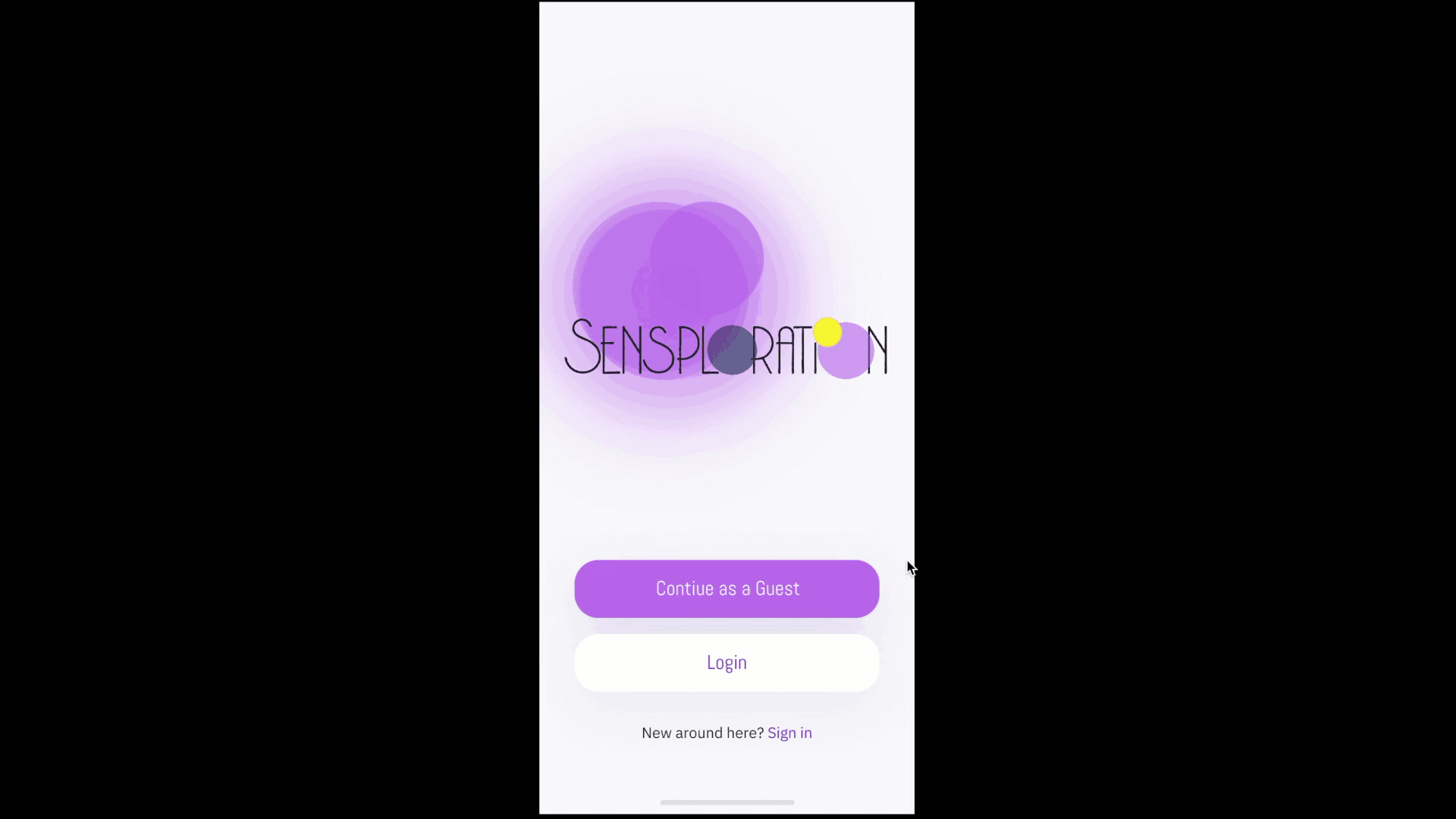
Though there are a number of ways to address the problem we wanted to solve, we chose to do it through a mobile application. We wanted envision an app that is radically inclusive in how people are invited to explore experiences, sensuality, and potentially sexuality.
Sensploration is an app with thematic activities that offer people new approaches to explore and enjoy their body using the five senses and the intersections between them.
To do this, we designed an app that:
- Allows for guest access (for privacy) and logins (for personalisation)
- Has a guided start with a touch-based activity
- Gives opportunities for user feedback so people can note what they like and don’t like (for future personalisation)
- When the user returns to the main page they can see the touch bubble that they have just practiced has grown to show progress. And new categories are unlocked.
- As a user explores more activities, each sense bubble grows bigger and eventually overlap, with new intersectional categories are unlocked.
As an example, touch can begin with light touches, deep touches. It can include pressing, holding, pinching, and tapping. But touch can also expand to materials, which can have its own subcategories such as textures and temperatures. Touch can also include movement and toys.
The goal of the app is to give people a framework through each of the senses to explore their and their partners’ bodies. In the long run, the user’s knowledge of what they enjoy is expanded, and they have the tools needed to openly communicate what they enjoy to others. By focusing on senses and activcities, we remap how we think about pleasure and intimacy, dismantling stigmas, shame, and taboos.
We also wanted to intentionally create a more inclusive app that could
- speak to different gender identities (without alienating)
- be mindful of how people may or may not relate to different parts of their bodies (for example, trans and genderqueer folks)
- get away from gendered descriptions or roles (not heteronormative)
- not limit concepts as sexual acts (for ACE folks)
- be inclusive of bodies with different abilities
- be inclusive of different types of bodies, shapes, and skin colours
- be accessible to people who may have difficulty reading (therefore the content would have both transcript and audio)
You can find the Figma mockup file here.
Rather than seeing all of these factors as limitations, we saw them as opportunities to design a better product from the beginning.
The Bigger Picture (aka Finances)
To understand our users and the market demand a little better, we looked at the second part of our survey.
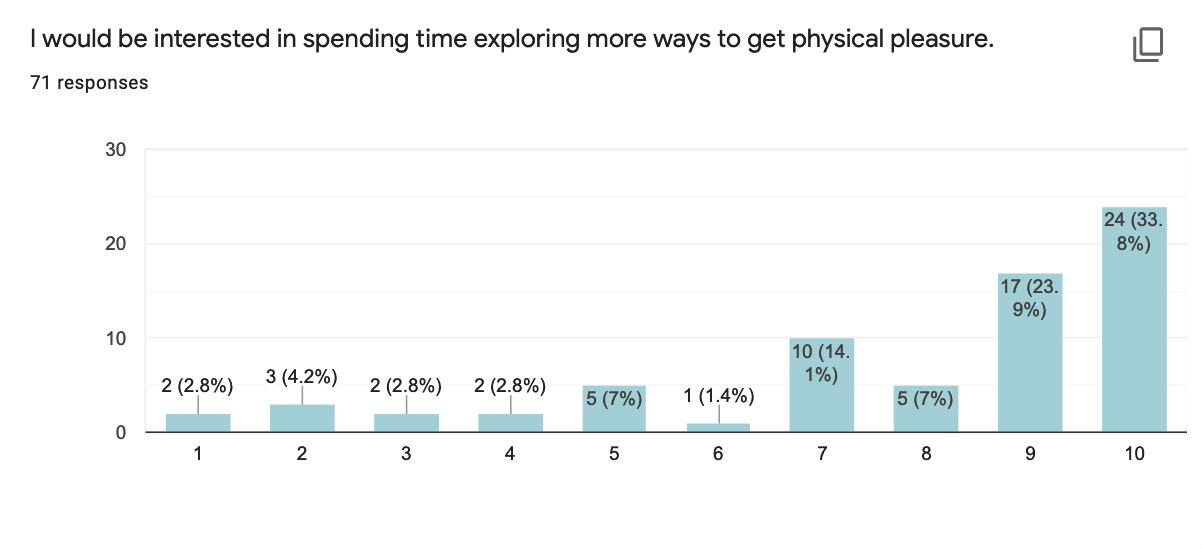
We found out that 90% of our sample believe that having more ways to experience bodily pleasure would be beneficial to them, 86% would like to try new ways to do it and 82% are interested in spending time doing so.
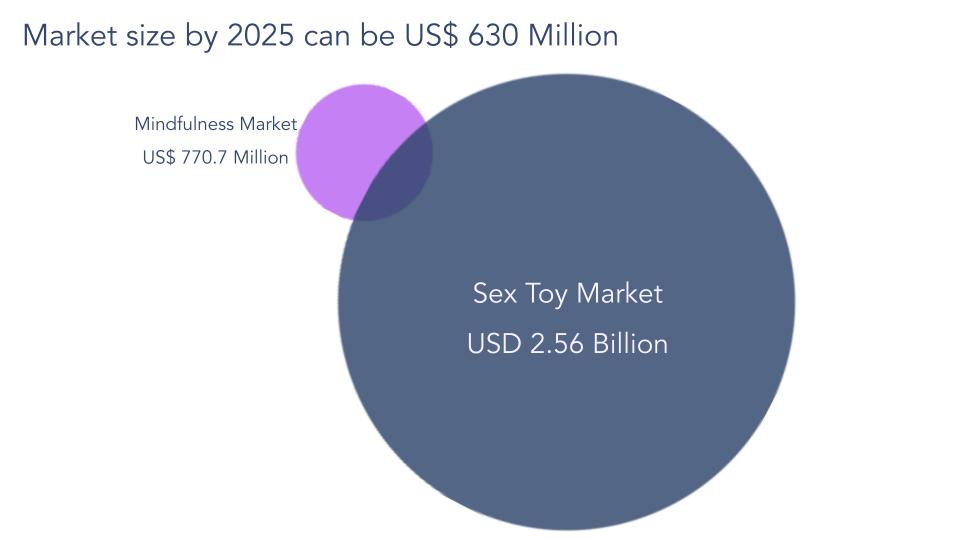
The addressable market is actually the intersection between mindfulness apps and the sex toy markets. In April, the mindfulness and meditation app market size (the likes of Headspace and Calm) was projected to be around US$ 770.7 Million by 2025. If that seems big, the sex toy market in Europe alone was estimated to grow to US$2.56 Billion in the Personal Products Industry during 2021-2025.
Industry precedents also come from different spaces and there are many indirect competitors. The most famous is OMG yes, which focuses on women and on their sexual pleasure. This form of targeting excludes non-women and asexual people, is the most common scenario. Other popular forms of competition comes from content creators on social media, such as for lesbian sex, to product blogs by Unbound Babes, Dame products or to apps like Clue. But topic specialization lacks inclusion for all types of people.
In short there is no holistic solution that covers body experiences, sensual pleasure and sexual pleasure, and that is also inclusive of different body types, sexualities, and abilities.
The reason we are talking about addressable market is because financial sustainability is important for long-term sustainability of a service.
The past 20 years of the internet have shown that if you do not pay for the product, you are the product. For this reason, we (or at least I specifically) do not believe in a freemium model. I want a product to be good enough to be paid for from day one. This means that the product does not need to be beholden to investors and does not need to grow users for the sake of accumulating numbers.
In addition, people have shown that they are willing to pay for quality content and support content creators. This is true across different parts of the sex industry. Examples include:
- OMG Yes: the educational site we mentioned before with a one-off paid fee for its educational content
- Karada House: a queer BIPOC-owned community space that hosts paid events such as rope, kink, and sexualities workshops and conferences
- Only Fans: perhaps the biggest paid content creator platform to emerge out of Covid-19
For an app, paid models could include:
- One-off paid app download: like buying a book
- Tiered model for introductory and advanced content
- Paid subscription (personally my least favourite for this app)
The Process
Our process of designing and preparing our presentation had structure, but also required back and forths.
Working backward from the presentation, we needed to find a way to convey our idea succinctly. The structure that lends itself well to a 5-10 minute presentation is (not surprisingly), a startup pitch. This meant that we structured it as:
- The problem we wanted to solve
- Finding data (quantitative and qualitative)
- Conceptualising a solution
- Deciding on the prototype
- Researching bigger market opportunities
- Preparing for the pitch
The tools we used included:
- Google Forms for the survey
- Google Slides for the presentation
- Figma for the mockups
- Unsplash for stock images
In general, we took longest for debates and discussions. A key debate was how the app worked and how the library of data would be structured. This was not ultimately shown, but since Ghonche and I both have product experience, it was a detail that mattered to us. Simply put, we would not go ahead and create designs for an app that we did not have a conceptual backend for.
Another debate point that we had was what to prototype with. Generally, I prefer building working prototypes over designing mockups. I had originally wanted to use Prezi to create the non-linear library of activities that the public could actually use by the end of the hackathon. However, when I learned that my team members wanted a guided user onboarding, with only one bubble available in the beginning and a growing library based on activities, we decided to go with the Figma mockup.
The final debating point was the presentation – the overarching story, which sections we were filling out, and who was doing which section. Ghonche is a slide wizard, so we largely left it to her. Since the product was Thomas’ idea, he took the slides she created and the script we worked on and presented. This works when everyone is on the same page about the general storyline. However, this method also requires allowing the speaker at least a final hour to do their own final touches to the slide and the script.
Most of our time was spent waiting. They waited for me to edit the survey questions while I made lunch. We waited for Ghonche to work on the presentation story and slides. We waited for Thomas to do his ideation in his bedroom. We all needed to wait for the survey results. This is not a bad thing. It meant we had time. We had time to chat, to have dinner, to go for walks and runs, had a full night’s sleep, and baked a cake.